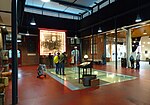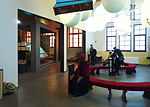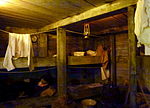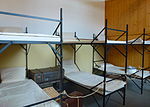Ballin City
 logo |
|
| Data | |
|---|---|
| place |
Hamburg-Veddel |
| Art |
Emigration Museum
|
| opening | 2007 |
| Website | |
| ISIL | DE-MUS-798712 |
The BallinStadt , proper spelling "BallinStadt - the Emigration Museum Hamburg" is a 2007 inaugurated Emigration Museum in veddel , which was built at the site of the emigration center. It was created over 100 years after the Hapag shipper Albert Ballin had the first emigration halls built in 1901. In three faithfully reconstructed buildings, BallinStadt focuses on emigration via Hamburg and migration movements from the 16th century to the present day.
history
Between 1850 and 1939 Hamburg was the “gateway to the world” for over five million European emigrants who were fleeing political and religious persecution or who simply left the “ old world ” via Hamburg to escape a life of poverty and hunger . In 1901, the general manager of Hapag, Albert Ballin , had mass accommodation built on the Elbe island of Veddel for thousands of emigrants who came to the city from all over Europe every week.
Ballin had taken over an emigration agency, Morris & Co., From his father, which carried emigrants via England to America on the Carr Line cargo ships . In 1886, Albert Ballin was hired by HAPAG as head of the passage department and given responsibility for the emigration business. The fact that Hamburg became Germany's leading port of emigration is largely thanks to Ballin's expansion of a network of emigration agents and branches that specialized in emigrants from Eastern and Southeastern Europe . In 1891, for the first time, more emigrants left Germany via Hamburg than via Bremen .
Emigration halls
Emigrant barracks at Amerikakai
The HAPAG , the emigrants, whose entry into the United States was rejected, had to return at their own expense, offered to set up accommodation in Hamburg. This made it possible to check the emigrants before their departure and to put them in quarantine for 14 days . The “emigrant barracks ” at the Amerikakai in the Port of Hamburg were opened on July 20, 1892, and around 1400 people found accommodation here in - even for this time - very poor accommodation. All arriving emigrants who had a ship passage in the intermediate deck had to live there. The others were allowed to stay in town as before.
Move to the Veddel
In 1898 Hamburg needed the land on which the emigrant barracks stood to expand the port and offered the Veddel as an alternative . In 1901, HAPAG opened the “Emigration Halls” here. Through these specially built barracks, which had their own railway connection, the wave of emigrants - mostly from Eastern European countries - could be guided around the city. The new facility offered space for 1200 people in 15 buildings. There were five sleeping and living pavilions, two more comfortable accommodations ("Hotel Nord" and "Hotel Süd"), a large dining hall, washing and sanitary facilities in each sleeping pavilion, a synagogue and a church for the two Christian denominations as well as an administrative building. In addition, there was a bandstand where concerts were held, a hospital, baggage shed and a stable. In 1905 eight more barracks were built nearby.
At the beginning of the 20th century, the number of emigrants via Hamburg increased so much that the facilities were expanded in 1906/07 with an additional 18 accommodations, a block with separate kitchens and dining rooms for Jews and Christians, and a large reception building. At the end of this second phase of development, the emigration halls consisted of 30 buildings on 12.4 acres of land. In 1913 the highest level of over 170,000 emigrants was reached. Hamburg had become Germany's largest port of emigration. Between 1891 and 1914, almost 1.9 million people left Europe via the port on the Elbe - the vast majority for the USA, the main destination of European emigrants at the turn of the century .
With the outbreak of the First World War , these quarters were converted into a military hospital by the German Navy . After the war, emigrants began to emigrate again via the Hamburg emigration halls, but their number was only a fraction of those who had emigrated via the city in the first decade of the 20th century. Between 1918 and 1954 "only" around 300,000 emigrants were registered in Hamburg.
City of Hamburg becomes owner
In 1934, HAPAG handed over the emigration halls to the city of Hamburg. In April 1934 the Waffen SS moved into two thirds of the “Überseeheim” and on November 1, 1934, took over the entire complex. In 1939, many of the former "emigration halls" were demolished to make way for the Hamburg tram ; the main building was a victim of the construction of the four-lane Wilhelmsburger Reichsstraße , which connects Hamburg with Harburg . After the Second World War , the buildings became a home for bombed-out Hamburg families. A number of small businesses later used the buildings.
In 1962/63 the church building was torn down together with the sleeping barracks. The only remaining hall last housed a Portuguese restaurant and was also demolished in early summer 2004.
Today's museum
In July 2007, BallinStadt opened as a museum under the motto Port of Dreams - Hamburg Emigration World . In April and May 2016 the museum was rebuilt and expanded to an area of 2,500 m². The reopening took place on May 14, 2016 with a new logo and a new name. The BallinStadt Emigration Museum now shows the history of immigration and emigration from the 16th century to the present day using four epochs as examples.
The complex, which consists of three buildings, is a joint project between the Free and Hanseatic City of Hamburg and the Leisure Work Group GmbH. The City of Hamburg decided to build the BallinStadt Emigration World in December 2004, based on an overall concept developed by the Hamburg Maritime Foundation . The foundation stone was laid in December 2005. The project is financed as a so-called public private partnership between the city of Hamburg and sponsors provided by the Hamburg Maritime Foundation. The operating company BallinStadt mbH is responsible for the operation, the Museum der Arbeit is responsible for the overall project management. A supplementary permanent exhibition on the subject of "Hamburg as a city of emigrants" is being set up in the Museum for Hamburg History .
Until March 2016, the museum showed the history of the more than 5 million emigrants who left their homeland from Hamburg between 1850 and 1939 and dared the risky crossing to the New World in order to enable themselves a better life. With the extension of the operating contract between the City of Hamburg and the BallinStadt operating company until 2027, the main exhibition in House 2 and the historical part of the museum about the history of immigration and emigration over four epochs ("Neue Ufer" (16.– 19th century), “The long 19th century”, “The great wars of the 20th century” and “World in Transition” (after 1945)). The family research area and the restaurant (with shop) in House 3 have been preserved and have been modernized. You should plan several hours for a visit to the museum.
The museum can also be reached via a specially set up jetty. Operate it launches the Maritime Circle Line on, connects the various visitor attractions of the port with one another.
BallinStadt came under fire at the end of 2009 because the number of visitors fell short of expectations. In 2009, only 94,000 visitors came to the museum. They had expected 150,000 visitors per year. In response, the Friends of the Emigration City BallinStadt e. V. founded to enable further financial support for the museum.
Since January 2010 it has been possible for the immediate residents to visit the museum at a reduced price.
Pictures, exhibition
See also
literature
- Johann Hamann : My field is the world. The Hamburg emigration halls in Johann Hamann's photographs (1909). With a text by Ulrich Keller. Publishing house d. Buchh. König, Cologne 1981, ISBN 3-88375-012-3 .
- Simone Eick , In the New World! German emigrants in three centuries , Hamburg: Rowohlt Verlag, 2010, ISBN 978-3-498-01673-9
Web links
- Official website of Ballinstadt
- The BallinStadt. Picture gallery. on: welt.de , July 4, 2007.
- In the grip of the experience industry. ( Memento from May 8, 2012 in the web archive archive.today ) at: kunstmarkt.com , July 12, 2007.
- Hoping to Lure Visitors by Recalling Departures. In: The New York Times . July 14, 2007 in the
- Henning Cordes: Ballinstadt: Not everything is new, but different. on: ndr.de , May 13, 2016.
Individual evidence
- ↑ Monika Nellissen, Stefan Grund: Ballinstadt in crisis - Maritime Museum is expanding . on: welt.de , November 9, 2009.
- ↑ Self-portrait of the Friends of the Museum. Retrieved February 25, 2013.














